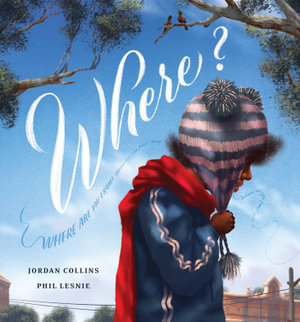Where? by Jordan Collins. Illus. by Phil Lesnie

The question, ‘where are you from’ was so often asked of the author, that while a teenager they wrote a poem underlining the commonness of us all. In this poem they highlight the beginnings of the universe, the big bang, the void and cosmic dust, the cataclysmic creation, the clouds, the oceans and the earth. We share common ancestors who decided to get up on two legs and walk, we shared voyagers and men and women who painted on cave walls and created their religions. The timeline of humanity includes all of us.
But they is often asked ‘where are you from’ because of the colour of their skin and hair, and affronted they say, ‘you see skin and I see supernovas, you see hair and I see nebulae’, impelling people to see that we all from the same place, so there is no need to ask again.
The word ‘where’ implies an overtone of racism as the questioner sees this person as not belonging. They are being questioned not about where they are from, but more why are you here? They are an ‘other’, someone not part of us, someone who does not belong.
This passionate poem draws readers’ attention to the idiocy of the question often heard. We are all born from the same seismic happenings in our universe, we share a common ancestry. For readers the story opens a slew of questions and observations. They will question the notion that people are ‘from’ somewhere other than the place they are at right now. The question of inclusivity and diversity will pop up, but overall the main thrust will be our common source. They do not want to be seen as ‘other’ but a human being like everyone else.
Performing this poem at a poetry event led to its publication, and along with the stunning illustrations by Phil Lesnie, will have an assured place in all school libraries. And I came across a new expression, slam poetry or poetry slams, where poems are performed to an audience, often loudly, and then judged by a panel. Typing ‘slam poetry’ into the internet gives you a range of performed poems at a slam.
For a wonderful synopsis of the book coupled with some heartfelt comments about its themes see here.
Lesnie’s illustrations are awe inspiring, as they show the universe in its magnificence, from the big bang to the swirl of cosmic dust, nebulae, moons, planets and suns, the seas and then the land upon which we first walked. He is able to give the impression of the sweep of the universe with his digital illustrations done on an iPad!. And the touches of Jordan’s lonely walks are heartfelt as he wanders along the highway or sits on a playground swing, walks along the beach leaving his single footprints on the sand. Through his journey his black cat is by his side, oblivious to the questions being asked of him, but a loyal and constant companion. The other child on the swing shows in his facial expressions the antipathy the question often reflects, while the faces on the audience at the poetry reading reflect sympathy and solidarity. An interview with Phil Lesnie can be found here.
This stunning contribution to the discussion about racism will draw in teachers and adults wanting to reconsider and discuss, while children will sympathise with Jordan and their journey tackling the big issue in all of our lives. An interview with Jordan can be found here.
Themes: Racism, Inclusivity, Universe, Big bang, Loneliness.
Fran Knight